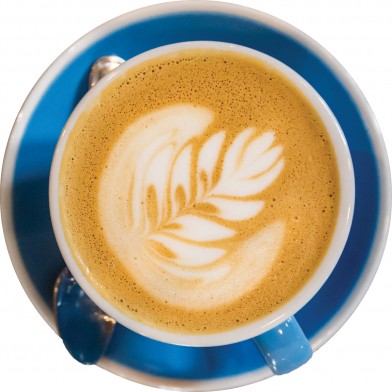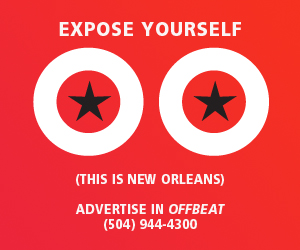What is she doing in there? A woman in her early twenties, brown hair, sitting in a parked car at a gas station in the middle of nowhere, with circular movements perceivable through the windshield. What’s going on?
Meet Lauren Fink, one of New Orleans’ new coffee queens and proprietor of Cherry Coffee, which still operates out of its original location inside Stein’s Deli on Magazine Street near Jackson Avenue, but since March also in a bright new location in what used to be a fire station by Wisner Playground at Laurel and Upperline Streets, down from Le Bon Temps Roulé, deep into the residential neighborhood.
Fink drove here cross-country from Portland, hand-grinding her own coffee in her ’84 Chevy Silverado, sourcing hot water from gas stations along the way. She’s committed, you could say, to excellent coffee no matter where she is. When she goes camping she brings along her AeroPress.
“I don’t get to travel a whole lot, but I take short trips to the beach,” she says. “I take my dog, and I bring my own coffee. The AeroPress is nice because it’s plastic, you can’t break it, so all I need is hot water and my grinder. I’m ridiculous, but coffee is important to me. Those are an important 15 minutes that I thoroughly enjoy.”
When Fink first moved to New Orleans five years ago, the local reference point for coffee was still chicory and dark roast. What’s become known as third-wave coffee had not yet hit the Gulf Coast.
“The attitude in New Orleans is still very much that you drink coffee in the morning to get caffeinated,” Fink says. “That’s what you do to start your day, but where we’re going is more of a culinary experience. It’s not about putting in milk and sugar and getting it down as quickly as possible to get you where you need to go. It’s supposed to be a sensory journey. You’re supposed to pay attention.”
Historically, the so-called first-wave put coffee in almost every kitchen in America. Think Folgers and Maxwell House, mass marketing along with technical innovations such as airtight cans and instant coffee that brought the product onto grocery stores’ shelves and into soldiers’ rations. The second-wave was as a reaction to the “bad coffee” of the first. Here came the cult of espresso drinks, big companies like Peet’s and Starbucks, coffee shop culture and some degree of snobbery surrounding specific origins, such as Brazilian and Colombian beans, as well as roasting styles.
“When I came down, New Orleans had PJ’s and CC’s and Rue de la Course, and those were small businesses, so kind of cool, but they didn’t serve the coffee we have now,” says Fink.
Third-wavers like her think of coffee as an artisanal craft beverage, not unlike wine or beer. It’s all about freshness (beans are generally sold with the roasting date displayed on the package), direct relationships with farmers and roasters, and teasing out the essential flavors from each bean, respecting what it has to offer and enjoying those qualities in their purest form. This requires light to medium roasts rather than dark or French roasts, explains Fink: “It’s easy to roast coffee, but it’s quite hard to nail the balance between acidity and sweetness. What’s happening in the roasting process is that you’re caramelizing the natural sugars in the coffee and the acidity changes into sugar then to caramel to burnt sugar as you roast it longer.
“The East Coast and the West Coast have different roasting styles. Coffee from the East Coast is more developed, more savory, a heavier mouth-feel—rich, I’d say—with coffees from Guatemala and Brazil. Then on the West Coast there are higher-end notes, higher acidity and lighter roasts. Might be a little bit more delicate, but with a lot of flavor. I try to bring in both to show people what’s out there. Comparison is the best way to learn, so we do cuppings on Sundays for our customers.
“Lately, I’ve been playing around with a sample roaster. I’d like to get that ball rolling, roasting my own coffee. I should do a Kickstarter, honestly. ‘Hey, New Orleans! I want to roast your coffee!’ That’s where I see myself going next.”
For a short while after moving here, Fink worked as a barista for Brigade, the specialty coffee truck that used to park in front of Stein’s Deli.
“Eventually Dan [Stein] asked them if they wanted to move into his place,” she remembers. “But they said, ’No. It smells bad in there.’ That was right around the time when I was ready to make a move so I talked to Dan myself and that’s how Cherry got started.
“Working for Brigade was frustrating. They’d buy a large amount of coffee, which has a shelf life of two weeks, and I’d be trying to make good coffee with month-old coffee. It wasn’t working.”
Going from being a barista to a business owner was a big step for Fink, who nevertheless had worked in coffee since high school.
“In the beginning, it was just a fun job,” she says. “But I didn’t know what I was doing until I went through Stumptown’s training program in Portland and learned how different coffee can taste. I had no idea. I was drinking caramel lattes, you know, when I was ‘little.’ Tasting black coffee was mind-blowing.”
Today, Fink wouldn’t even hire the barista she herself used to be. Her employees work with scales and timers and high-end equipment. There are no buttons to press, no thermoses.
What motivates her more than anything is blowing other peoples’ minds with the complexities of flavors she’s able to express from coffee beans.
“At Stein’s, where people would come in for a sandwich and end up ordering an espresso after their meal, I’d hear on a regular basis, ‘I had no idea coffee could taste like this,’” she says. “Those reactions kept me going. All of a sudden, coffee wasn’t just coffee to them anymore.”
Across town, Lauren Morlock runs Solo Espresso on Poland Avenue in the Bywater. She lives upstairs, which helped a lot when she opened three years ago and was the only one working—except for her husband, who made coffee deliveries on skateboard.
“We’d deliver mochas and lattes and cold brew to anywhere between Press Street and the Industrial Canal, the Mississippi and Claiborne [Avenue],” she remembers. “Delivery was tricky. I did it on bike. We created all kinds of different contraptions to hold the coffee. I’d just close the door with a note on it, ‘Be right back.’”
Solo was originally supposed to be run as a pop-up in a neighborhood bar. When that fell through and Morlock already had bought all the equipment, she simply set it up in her basement, handed out flyers and ran Solo as a coffee speakeasy for eight to nine months. Once people started coming on a consistent basis, it made sense to stop delivering and instead run the business as a coffee shop. Now she hosts food pop-ups each Saturday, addressing neighbors’ breakfast needs. Morlock admits having a sweet spot in her heart for Cuban coffee, which is black as night, thick and syrupy, but Solo relies exclusively on lighter roasts from a variety of roasters, primarily Panther in Miami. She gets her dairy from Mauthe’s Progress Milk Barn in McComb, Mississippi and her sugar from Three Brothers Farm in Youngsville, Louisiana.
For consistency, Morlock keeps a recipe log. Each week, she comes up with a baseline recipe (coffee to water ratio, weight and time measurements) for her baristas to follow using the beans that are currently available. When the baristas come in for work each morning, they individually tweak the recipe for an optimal brew.
“Coffee is forever changing,” Morlock says. “Every day, it releases carbon dioxide, and there are so many variables. With a finer grind, you get more surface area to extract from, but you also create more resistance, which means that it takes the water longer to pass through the grinds. The goal is beautiful flavors in a consistent cup of coffee every day.”
The port of New Orleans was always the first stop for a large portion of green coffee beans coming into the U.S. For more local coffee history—and a reality check if you imagine that we’ve reached a point of saturation when it comes to coffee shops in the city—read the sidebar.





